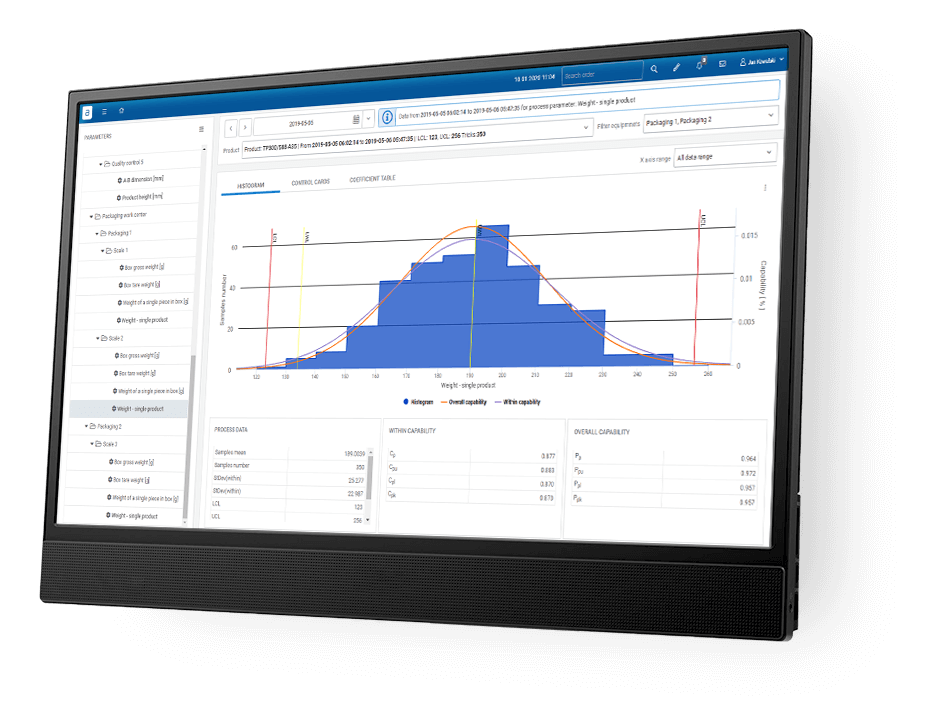Digitalization means that reporting in its traditional form, as we have known it for years – in paper form, symbolically passed from hand to hand – is a thing of the past. Today, production, quality or maintenance reports can – and should – be filled out automatically and then distributed in the same way within the company structures. How does this work in practice?
A company’s automated report means, above all, an increase in productivity and a reduction in manual workload. There is also, of course, a better response time to a potential problem. Here are the benefits of implementing automation in report generation.
A paper report means:
- higher product and printing costs
- more work in processing the documentation
- space required for archiving reports
- Manual filling and double reporting – from paper to ERP
As a result, digitalization of paper documents is becoming more commonplace – improving the flow of information and reducing communication delays. It also allows better control over the flow of messages: some data is reported by the operator on the panel when requested, or data is filled in automatically – from machines.
Digitalization in authorising decisions is another issue – in the case of reports, digital signatures bring this process to a higher level of security. This can be seen in the example of production steps. Operators confirm each of them, which provides assurance that none of them is overlooked.
In practice, the digitalization of documentation means that monitoring – not just KPIs – in production takes place directly on the computer screen in the office. The manager has full access to the aggregated data in real time and is quickly notified of problems, defects and failures.
Automatic Data Acquisition from machines
Auto-filling reports – by downloading data directly from the machines – results in reduced operator involvement. This practically eliminates paperwork, which tends to be burdensome and intricate. As evidenced by analyses, this increases the level of involvement in the production process. It is important to note that Automatic Data Acquisition does not only have to concern modern machines – via communication with the PLC. Older machines can also provide this type of information transfer through appropriate modernisation – equipping with sensors.

Integration with production reports and ERP integration
Accurate and comprehensive production reports are the foundation for every aspect of the process: from planning to activity accounting. Automation based on ERP integration makes it possible to:
- obtain complete data on the real time of a given production cycle
- generate information on the progress of production
- evaluate states of machines
- the number of compliant items in relation to those detected,
- the reasons for possible errors detected in the production cycle,
- ID of the operator responsible for the batch,
- operation start and end times,
- reason for stopping the machine,
- update of the scheduled completion,
- operation and order time,
- current status of the machine,
- other production progress data.
Production quality reporting
Thanks to automation, reporting on production quality is done in real time. In this way, information about defects occurring in production is analysed. It is important that the controller has full control over the ongoing assessment – here and now. For instance, the manager can ask the operator to perform quality checks with detailed instructions for a specific production time, if necessary. This allows, for example, to carry out inspections every 2 hours or in certain batches – e.g. when several hundred components are produced.
The overall inspection capabilities are enhanced by additional equipment. The system allows the connection of the necessary report automation tools- checkweighers, callipers or scanning machines.
Digitisation of SPC reports and control charts
Real-time condition monitoring is not just about current efficiency, but it also leads to significant improvement when it comes to drawing conclusions for the future. For example, automation makes it possible to verify whether certain measurements are within tolerance limits. Such reports can be generated automatically after production is completed. This reduces the involvement of human labour.

Reporting service problems
A common drawback of production lines is to slow response to technical problems. This is due to the late transmission of information. Automation eliminates this problem. Information about failures or maintenance needs is triggered automatically, along with the detailed reason. The generated notifications have different formats: e-mail, SMS, phone call. This reduces the risk of not receiving a message.
Maintenance activity reporting includes automatic measurement of maintenance KPIs – MRT, MTBF, MTTR, MTTF. The storage of data on the failure history itself – including not only causes but also repair or reaction times – runs in the background too.
Access from mobile devices
How to improve employee awareness and control over the production process? The solution is to provide employees with mobile devices – not just smartphones but, for instance, tablets – that have access to relevant applications. This way, they can report potential problems and their causes more quickly. Access to notifications is in real time. In addition, selected employees can access the current status of production – for example, in the form of OEE reports for a specific machine.
How to automate reports with the ANT MES solution?
The ANT automated reporting system is already being used in 35 countries. Customers who have decided to use the system point out, among other things, the variety of possible applications. Based on the system, it is possible to create the following reports:
- production reports
- quality reports
- maintenance reports and others.
Data collection not only applies to newer devices but is also possible for older models thanks to the knowledge and experience of ANT engineers.
Data analysis is facilitated by the extremely functional and practical dashboards developed by ANT. These are ready-made solutions based on the best experiences from various industries – FMCG, pharmaceutical, automotive, machine or aerospace. The company can therefore be sure to receive a ready-made solution adapted to the specifics of its business.
Reports collected in this way can be customised to meet company standards and reports can be generated on an ongoing basis. How does this work in practice? There is nothing wrong with, for example, sending out a series of reports in the early hours of each day with a summary of the last shift to start daily meetings with up-to-date last-day results.
This type of data analysis may include, for example:
- overall data with the total OEE and level broken down to the individual results of each department or production line
- a production line with the actual machine conditions during a shift and the OEE
- the performance of the production line with comparisons to a selected period in the past
- Pareto charts of microstops with the root causes for each machine or production line.
How to automate reports in practice – a case study
How does an automated reporting system work in a company? Here is an example based on an implementation for a company with 45 production lines. It operates in the automotive industry.
The implementation was possible thanks to:
- obtaining data from PLCs and control panels running on 26 modern devices
- installing sensors to count finished parts; they were installed on nine older machines
- installing control panels on ten manual assembly lines to obtain information on production progress
- installing ten 42-inch screens to provide greater transparency and allow dashboards to be displayed on the production floor.
How has the digitalization of production reports translated into measurable parameters? After the integration into the SAP ERP system, the operating time in particular has increased by 23%. At the same time, the time spent on quality control has been reduced by 45%. However, the overall reduction in production reporting time, which fell by 90%, is particularly impressive.
Products in this Article

Manufacturing Operations Management System (MOM)
Manufacturing Operations Management System (MOM) The most complete manufacturing solution with full support for operations management and a link between industrial automation and business operations

OEE Performance monitoring
Performance Monitoring (OEE) Connect and gather data from your machines. Schedule a Demo They Trusted Us: Key Benefits OEEincrease ✔️ shorter downtimes ✔️ faster production

MES System – Manufacturing Execution System – ANT Solutions
System MES – Manufacturing Execution System 0 % operating time increase 0 % defects quantity reduction 0 % material consumption reduction 0 % changeovers time

